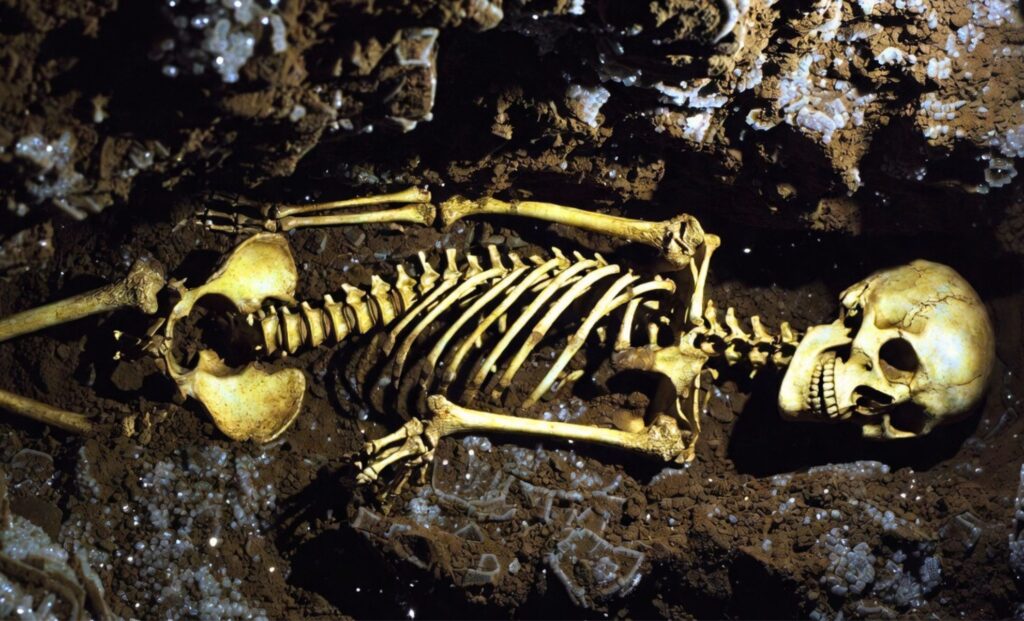In a rock-cut tomb 275 kilometers south of Cairo, a man was laid to rest more than 4,500 years ago—his bones sealed inside a ceramic vessel and tucked into a limestone chamber near the edge of the Nile. Now, that modest pot burial has delivered a historic scientific breakthrough: the first complete genome sequenced from Ancient Egypt’s Old Kingdom.
The man’s teeth, carefully excavated and processed under sterile conditions, preserved enough DNA to reveal something no artifact ever could—a direct genetic link between North Africa and Mesopotamia at the dawn of Pharaonic civilization. The data suggest that people, not just ideas or technologies, were moving between these ancient cultural superpowers.

Radiocarbon dating places the burial between 2855 and 2570 BCE, during the same era when Egypt’s earliest pyramids began to rise. The man died in his sixties, stood roughly 5’3”, and bore signs of osteoarthritis and upper limb strain—evidence of a life of skilled manual labor. Yet his high-status burial proposes a social role that remains difficult to reconstruct.
A Rare Genetic Window Into the Old Kingdom
Published in Nature in October 2025, the genome was sequenced by researchers at Liverpool John Moores University and the Francis Crick Institute, led by Adeline Morez Jacobs and Pontus Skoglund. Working from two molars, the team achieved about twofold genome coverage—remarkably high given Egypt’s heat and long-known DNA degradation challenges. The results were authenticated by low contamination rates and clear molecular damage patterns associated with ancient DNA.
“Piecing together all the clues from this individual’s DNA, bones and teeth has allowed us to build a comprehensive picture,” said Jacobs, as reported by Earth.com.
According to the study in Nature, about 80% of the man’s ancestry aligns with ancient North African sources—most closely with Neolithic Moroccan genomes—while the remaining 20% is linked to eastern Fertile Crescent populations, especially those from ancient Mesopotamia. The burial location, Nuwayrat near Beni Hasan, places him squarely within the heart of early dynastic Egypt, a period defined by state formation and the emergence of writing, monumental building, and centralized rule.


The man’s diet and isotope analysis confirmed a Nile Valley upbringing, making it unlikely that he himself migrated from the east. Instead, the data support earlier movements of people into Egypt from Mesopotamia prior to his lifetime—possibly during the consolidation of early dynastic power.
Mesopotamian Ancestry Deepens East-West Migration Models
The discovery builds on earlier research but goes further in time and resolution. A 2017 study in Nature Communications analyzed partial genomes from 90 Egyptian mummies dated between 1388 BCE and 426 CE, finding strong genetic continuity with ancient Near Eastern populations and limited sub-Saharan African ancestry. That study, however, covered later periods of Egyptian history and relied on far less complete data.


By contrast, the 2025 genome from the Old Kingdom predates those samples by over 1,000 years and represents a full nuclear sequence, allowing for more precise ancestry modeling. The researchers used qpAdm admixture analysis to test possible sources, ruling out single-population origins and identifying a two-way mixture as the best statistical fit.
“This is the first genetic evidence for potential movements of people in Egypt at this time,” said Skoglund, co-author of the study.
The man’s ancestry is consistent with known cultural links between Egypt and Mesopotamia in the late 4th and early 3rd millennia BCE. These include the spread of pottery styles, administrative technologies, and urban planning motifs. Until now, there was no biological confirmation that people—not just ideas—were part of those exchanges.
Pot Burials and Preservation Breakthrough
The success of this sequencing effort may owe as much to burial conditions as to laboratory technique. The man’s skeleton was placed inside a large ceramic pot, then sealed in a limestone-cut tomb that maintained a stable, cool microclimate. Unlike mummified remains, which are often compromised by embalming chemicals, this burial left DNA largely intact.
Researchers extracted DNA specifically from cementum-rich tissue in the tooth roots, which tends to preserve genetic material better than bone. These strategies, combined with clean-room protocols, may offer a roadmap for recovering more genomes from hot-climate contexts like Egypt.
The individual’s life story is also written in his bones. Despite a relatively prestigious burial, his skeleton shows signs of intense physical wear. Researchers suggest he may have been a potter or artisan, based on skeletal stress in the knees, hips, and upper arms consistent with long hours sitting and repetitive motion.
“Though circumstantial, these clues point towards pottery, including use of a pottery wheel,” said Joel Irish, bioarchaeologist and study co-author.
The Old Kingdom genome points to a more interconnected prehistoric world, in which Egypt’s rise was tied not only to the Nile’s geography but also to long-distance human flows across the Red Sea, the Sinai, and the eastern Mediterranean.
It also reframes the timeline for sub-Saharan African ancestry in Egypt. While modern Egyptians show a genetic signature from sub-Saharan populations, this earlier genome lacks that component entirely. Instead, the dominant ancestry reflects Neolithic North Africa and early West Asia—a profile more consistent with pre-Islamic and pre-Roman Egypt.

